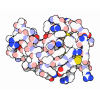| 登録情報 | データベース: PDB / ID: 5zty
|
|---|
| タイトル | Crystal structure of human G protein coupled receptor |
|---|
 要素 要素 | G protein coupled receptor,T4 lysozyme,G protein coupled receptor |
|---|
 キーワード キーワード | MEMBRANE PROTEIN / GPCR / cell signaling / ligand design |
|---|
| 機能・相同性 |  機能・相同性情報 機能・相同性情報
trans-synaptic signaling by endocannabinoid, modulating synaptic transmission / negative regulation of mast cell activation / negative regulation of synaptic transmission, GABAergic / cannabinoid receptor activity / negative regulation of action potential / Class A/1 (Rhodopsin-like receptors) / leukocyte chemotaxis / extrinsic component of cytoplasmic side of plasma membrane / regulation of metabolic process / G protein-coupled receptor signaling pathway, coupled to cyclic nucleotide second messenger ...trans-synaptic signaling by endocannabinoid, modulating synaptic transmission / negative regulation of mast cell activation / negative regulation of synaptic transmission, GABAergic / cannabinoid receptor activity / negative regulation of action potential / Class A/1 (Rhodopsin-like receptors) / leukocyte chemotaxis / extrinsic component of cytoplasmic side of plasma membrane / regulation of metabolic process / G protein-coupled receptor signaling pathway, coupled to cyclic nucleotide second messenger / viral release from host cell by cytolysis / peptidoglycan catabolic process / response to amphetamine / adenylate cyclase-activating G protein-coupled receptor signaling pathway / cell wall macromolecule catabolic process / lysozyme / lysozyme activity / perikaryon / G alpha (i) signalling events / response to lipopolysaccharide / postsynaptic membrane / host cell cytoplasm / defense response to bacterium / immune response / inflammatory response / dendrite / endoplasmic reticulum / plasma membrane / cytoplasm類似検索 - 分子機能 Cannabinoid receptor type 2 / Cannabinoid receptor family / Lysozyme - #40 / Endolysin T4 type / T4-type lysozyme / : / Glycoside hydrolase, family 24 / Phage lysozyme / Lysozyme domain superfamily / Serpentine type 7TM GPCR chemoreceptor Srsx ...Cannabinoid receptor type 2 / Cannabinoid receptor family / Lysozyme - #40 / Endolysin T4 type / T4-type lysozyme / : / Glycoside hydrolase, family 24 / Phage lysozyme / Lysozyme domain superfamily / Serpentine type 7TM GPCR chemoreceptor Srsx / Lysozyme / G-protein coupled receptors family 1 signature. / Lysozyme-like domain superfamily / G protein-coupled receptor, rhodopsin-like / GPCR, rhodopsin-like, 7TM / G-protein coupled receptors family 1 profile. / 7 transmembrane receptor (rhodopsin family) / Orthogonal Bundle / Mainly Alpha類似検索 - ドメイン・相同性 Chem-9JU / OLEIC ACID / (2R)-2,3-dihydroxypropyl (9Z)-octadec-9-enoate / DI(HYDROXYETHYL)ETHER / Endolysin / Cannabinoid receptor 2類似検索 - 構成要素 |
|---|
| 生物種 |  Homo sapiens (ヒト) Homo sapiens (ヒト)
 Enterobacteria phage T4 (ファージ) Enterobacteria phage T4 (ファージ) |
|---|
| 手法 |  X線回折 / X線回折 /  シンクロトロン / シンクロトロン /  分子置換 / 解像度: 2.8 Å 分子置換 / 解像度: 2.8 Å |
|---|
 データ登録者 データ登録者 | Li, X.T. / Hua, T. / Wu, L.J. / Liu, Z.J. |
|---|
 引用 引用 |  ジャーナル: Cell / 年: 2019 ジャーナル: Cell / 年: 2019
タイトル: Crystal Structure of the Human Cannabinoid Receptor CB2
著者: Li, X. / Hua, T. / Vemuri, K. / Ho, J.H. / Wu, Y. / Wu, L. / Popov, P. / Benchama, O. / Zvonok, N. / Locke, K. / Qu, L. / Han, G.W. / Iyer, M.R. / Cinar, R. / Coffey, N.J. / Wang, J. / Wu, M. ...著者: Li, X. / Hua, T. / Vemuri, K. / Ho, J.H. / Wu, Y. / Wu, L. / Popov, P. / Benchama, O. / Zvonok, N. / Locke, K. / Qu, L. / Han, G.W. / Iyer, M.R. / Cinar, R. / Coffey, N.J. / Wang, J. / Wu, M. / Katritch, V. / Zhao, S. / Kunos, G. / Bohn, L.M. / Makriyannis, A. / Stevens, R.C. / Liu, Z.J. |
|---|
| 履歴 | | 登録 | 2018年5月5日 | 登録サイト: PDBJ / 処理サイト: PDBJ |
|---|
| 改定 1.0 | 2019年1月30日 | Provider: repository / タイプ: Initial release |
|---|
| 改定 1.1 | 2019年2月6日 | Group: Data collection / Database references / カテゴリ: citation
Item: _citation.journal_volume / _citation.page_first ..._citation.journal_volume / _citation.page_first / _citation.page_last / _citation.title |
|---|
| 改定 1.2 | 2023年11月22日 | Group: Data collection / Database references / Refinement description
カテゴリ: chem_comp_atom / chem_comp_bond ...chem_comp_atom / chem_comp_bond / database_2 / pdbx_initial_refinement_model
Item: _database_2.pdbx_DOI / _database_2.pdbx_database_accession |
|---|
| 改定 1.3 | 2024年11月6日 | Group: Structure summary
カテゴリ: pdbx_entry_details / pdbx_modification_feature |
|---|
|
|---|
 データを開く
データを開く 基本情報
基本情報 要素
要素 キーワード
キーワード 機能・相同性情報
機能・相同性情報 Homo sapiens (ヒト)
Homo sapiens (ヒト) Enterobacteria phage T4 (ファージ)
Enterobacteria phage T4 (ファージ) X線回折 /
X線回折 /  シンクロトロン /
シンクロトロン /  分子置換 / 解像度: 2.8 Å
分子置換 / 解像度: 2.8 Å  データ登録者
データ登録者 引用
引用 ジャーナル: Cell / 年: 2019
ジャーナル: Cell / 年: 2019 構造の表示
構造の表示 Molmil
Molmil Jmol/JSmol
Jmol/JSmol ダウンロードとリンク
ダウンロードとリンク ダウンロード
ダウンロード 5zty.cif.gz
5zty.cif.gz PDBx/mmCIF形式
PDBx/mmCIF形式 pdb5zty.ent.gz
pdb5zty.ent.gz PDB形式
PDB形式 5zty.json.gz
5zty.json.gz PDBx/mmJSON形式
PDBx/mmJSON形式 その他のダウンロード
その他のダウンロード 5zty_validation.pdf.gz
5zty_validation.pdf.gz wwPDB検証レポート
wwPDB検証レポート 5zty_full_validation.pdf.gz
5zty_full_validation.pdf.gz 5zty_validation.xml.gz
5zty_validation.xml.gz 5zty_validation.cif.gz
5zty_validation.cif.gz https://data.pdbj.org/pub/pdb/validation_reports/zt/5zty
https://data.pdbj.org/pub/pdb/validation_reports/zt/5zty ftp://data.pdbj.org/pub/pdb/validation_reports/zt/5zty
ftp://data.pdbj.org/pub/pdb/validation_reports/zt/5zty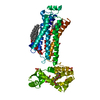
 リンク
リンク 集合体
集合体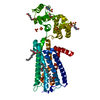
 要素
要素 Homo sapiens (ヒト), (組換発現)
Homo sapiens (ヒト), (組換発現)  Enterobacteria phage T4 (ファージ)
Enterobacteria phage T4 (ファージ)
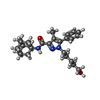
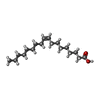
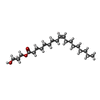
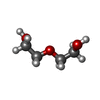
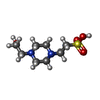
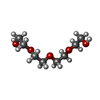









 X線回折 / 使用した結晶の数: 1
X線回折 / 使用した結晶の数: 1  試料調製
試料調製 シンクロトロン / サイト:
シンクロトロン / サイト:  SPring-8
SPring-8  / ビームライン: BL41XU / 波長: 1 Å
/ ビームライン: BL41XU / 波長: 1 Å 解析
解析 分子置換
分子置換 ムービー
ムービー コントローラー
コントローラー



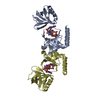

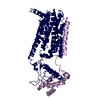
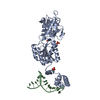

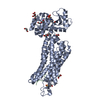




 PDBj
PDBj



